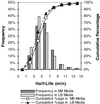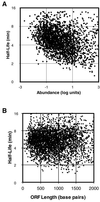Global analysis of mRNA decay and abundance in Escherichia coli at single-gene resolution using two-color fluorescent DNA microarrays
- PMID: 12119387
- PMCID: PMC124983
- DOI: 10.1073/pnas.112318199
Global analysis of mRNA decay and abundance in Escherichia coli at single-gene resolution using two-color fluorescent DNA microarrays
Abstract
Much of the information available about factors that affect mRNA decay in Escherichia coli, and by inference in other bacteria, has been gleaned from study of less than 25 of the approximately 4,300 predicted E. coli messages. To investigate these factors more broadly, we examined the half-lives and steady-state abundance of known and predicted E. coli mRNAs at single-gene resolution by using two-color fluorescent DNA microarrays. An rRNA-based strategy for normalization of microarray data was developed to permit quantitation of mRNA decay after transcriptional arrest by rifampicin. We found that globally, mRNA half-lives were similar in nutrient-rich media and defined media in which the generation time was approximately tripled. A wide range of stabilities was observed for individual mRNAs of E. coli, although approximately 80% of all mRNAs had half-lives between 3 and 8 min. Genes having biologically related metabolic functions were commonly observed to have similar stabilities. Whereas the half-lives of a limited number of mRNAs correlated positively with their abundance, we found that overall, increased mRNA stability is not predictive of increased abundance. Neither the density of putative sites of cleavage by RNase E, which is believed to initiate mRNA decay in E. coli, nor the free energy of folding of 5' or 3' untranslated region sequences was predictive of mRNA half-life. Our results identify previously unsuspected features of mRNA decay at a global level and also indicate that generalizations about decay derived from the study of individual gene transcripts may have limited applicability.
Figures



References
Publication types
MeSH terms
Substances
Grants and funding
LinkOut - more resources
Full Text Sources
Other Literature Sources
Molecular Biology Databases

